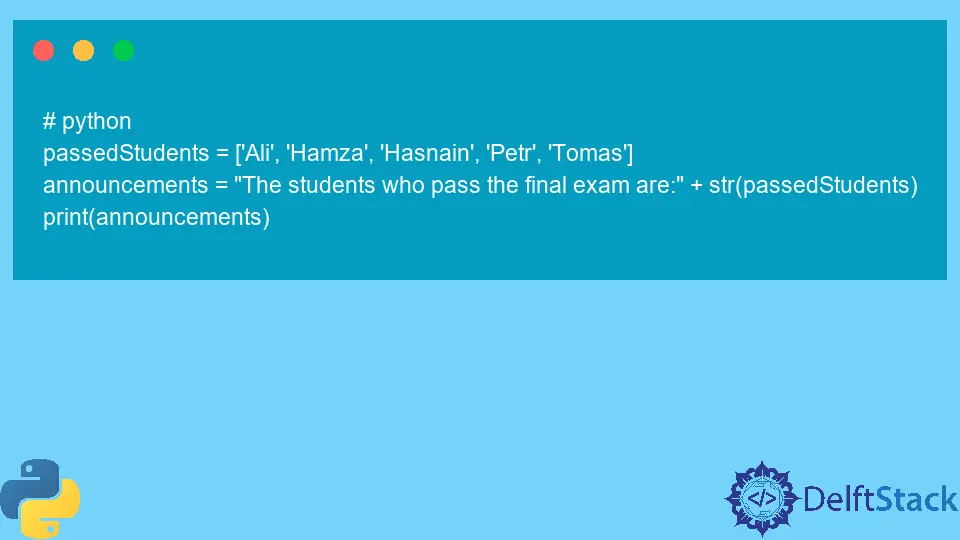How to Python TypeError: Can't Convert 'List' Object to STR
-
Using the
join()Method - Using List Comprehension with str()
- Using a Loop to Concatenate Strings
- Conclusion
- FAQ

When working with Python, encountering errors is part of the learning process. One common error that many developers face is the TypeError: Can’t convert ’list’ object to STR. This error usually occurs when you attempt to concatenate a list directly with a string, leading to confusion.
In this article, we will demonstrate effective methods to convert a list object to a string in Python. By understanding how to tackle this issue, you can improve your coding skills and avoid common pitfalls. So, let’s dive into the various ways you can convert lists to strings seamlessly.
Using the join() Method
One of the most efficient ways to convert a list to a string in Python is by using the join() method. This method is particularly useful when you want to concatenate elements of a list into a single string with a specified separator.
Here’s how you can use it:
my_list = ['Python', 'is', 'fun']
result = ' '.join(my_list)
print(result)
Output:
Python is fun
The join() method takes each element of the list and combines them into a single string, using the specified string (in this case, a space) as a separator. This makes it ideal for creating readable sentences or phrases from lists. If you want to use a different separator, simply replace the space in ' '.join(my_list) with your desired character, such as a comma or a hyphen.
This method is not only straightforward but also efficient, especially for larger lists. It’s worth noting that all elements in the list must be strings; otherwise, you will encounter a TypeError. To handle non-string elements, you might consider converting them to strings first.
Using List Comprehension with str()
Another approach to convert a list to a string is to use list comprehension combined with the str() function. This method allows you to convert each element of the list to a string before joining them together.
Here’s an example:
my_list = [1, 2, 3, 'Python']
result = ' '.join([str(item) for item in my_list])
print(result)
Output:
1 2 3 Python
In this code, we use list comprehension [str(item) for item in my_list] to create a new list where each element is converted to a string. The join() method then takes this new list and combines the elements into a single string. This approach is particularly useful when your list contains mixed data types, ensuring that all elements can be concatenated without raising a TypeError.
List comprehension is not only concise but also enhances code readability. You can easily modify the separator in the join() method to fit your needs, making this method versatile for various applications.
Using a Loop to Concatenate Strings
If you prefer a more manual approach, you can use a loop to iterate through the list and concatenate the elements into a string. This method gives you complete control over how the concatenation occurs.
Here’s how you can do it:
my_list = ['Python', 'is', 'awesome']
result = ''
for item in my_list:
result += item + ' '
print(result.strip())
Output:
Python is awesome
In this example, we initialize an empty string result and then iterate through each item in my_list. During each iteration, we concatenate the current item along with a space to the result. Finally, we use the strip() method to remove any trailing spaces from the final string.
While this method is straightforward, it may not be as efficient as using join() or list comprehension, especially for larger lists. However, it can be beneficial when you need to apply additional logic during the concatenation process, such as adding different separators or performing checks on each element.
Conclusion
Converting a list to a string in Python is a fundamental skill that can help you avoid common errors like the TypeError: Can’t convert ’list’ object to STR. By utilizing methods such as join(), list comprehension with str(), or even a simple loop, you can effectively handle lists and create readable strings. Understanding these techniques will not only enhance your coding abilities but also improve the quality of your Python programs. Remember to choose the method that best fits your specific needs and coding style.
FAQ
-
What causes the TypeError: Can’t convert ’list’ object to STR?
This error occurs when you try to concatenate a list directly with a string without converting the list elements to strings first. -
Can I use the join() method with a list that contains non-string elements?
No, thejoin()method requires all elements in the list to be strings. You can convert non-string elements usingstr()before joining.
-
Are there performance differences between the methods discussed?
Yes, usingjoin()is generally more efficient than concatenating strings in a loop, especially for larger lists. -
Is it possible to use different separators with the join() method?
Absolutely! You can specify any string as a separator in thejoin()method, such as a comma, space, or any other character. -
How can I convert a list of numbers to a string?
You can use list comprehension withstr()to convert each number to a string before using thejoin()method.
Rana is a computer science graduate passionate about helping people to build and diagnose scalable web application problems and problems developers face across the full-stack.
LinkedInRelated Article - Python Error
- Can Only Concatenate List (Not Int) to List in Python
- How to Fix Value Error Need More Than One Value to Unpack in Python
- How to Fix ValueError Arrays Must All Be the Same Length in Python
- Invalid Syntax in Python
- How to Fix the TypeError: Object of Type 'Int64' Is Not JSON Serializable
- How to Fix the TypeError: 'float' Object Cannot Be Interpreted as an Integer in Python
